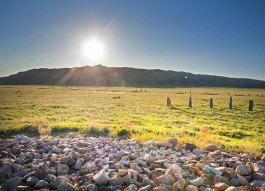
 Natural Heritage Monuments
Natural Heritage Monuments
The relics of the Tasmola culture belong to the Saka period (VII-III BC) and most of them are located in the same area of the precedent Begazy-Dandybai culture, in picturesque valleys surrounded by mountains, in Central Kazakhstan.
The main monuments of the culture are stone complexes having as dominant characters: one up to four stone barrows, accompanied by menhirs, single or in group, and by two curved stone ranges ('moustaches') 50-200 m. long, departing from the barrows and going east. This last element is an exclusive feature of the Tasmola culture.
The barrow, when single, contains always pottery, traces of fire and horse skeletons, but never human remains. The beginning and the end of the stones' ranges show alignments with equinoctial, solstitial and / or midsummer sunrise points. The monuments are often located near barrows with burials of noblemen and priests, but also near burials of ordinary people, settlements and mines, so their function doesn't seem to be specifically funerary.
Their main elements suggest the possibility that they have been ritually built by the first steppe nomads during grandiose celebrations and horse sacrifices. The new religious syncretism between sun, horse, fire and hero-ancestors is the ideological reflection of the socio-economical changes that happened in the steppes at the beginning of the I° millennium and that survived until our century: the establishment of the pastoralist nomadic way of life based on horse riding and long-range annual transurnances, and its social regulation by tribal confederation and aristocratic stratification.
The barrows with stone ranges of Tasmola are representing the first turning point of this immense historical process. About 300 barrows with stone ranges have been found in Kazakhstan. Only few of them have been archaeologically excavated.
The 75% are concentrated in the territory under consideration; the others spread in every direction in the other regions of the country, showing the power of diffusion of the Tasmola culture.

Set around the lush Tamgaly Gorge, amidst the vast, arid Chu-Ili mountains, is a remarkable concentration of some 5,000 petroglyphs (rock carvings) dating from the second half of the second millennium BC to the beginning of the 20th century.

Saryarka - Steppe and Lakes of Northern Kazakhstan comprises two protected areas: Naurzum State Nature Reserve and Korgalzhyn State Nature Reserve totalling 450,344 ha.

The cultural landscape of Ulytau is situated in the semi-desertic zone of Central Kazakhstan and it shows all its typical natural features: low mountains, conical-shaped hills, plains, river valleys and lakes.

The natural object of nomination is located on the northern macrohillside of the ridge Trans-Ili Ala-Tau, which is the part of Northern Tyan Shan physical geographic province (Gvozdetskiy, Nikolaev, 1971).

Altyn-Emel State National Nature Park is sprawled in the heart of Central Asia, in the valley of the Ili River, about 150 kilometers away from Almaty, Kazakhstan’s largest city.

The Aksu-Zhabagly Nature Reserve is the oldest nature reserve in Central Asia. It is located in the southern province of the Republic of Kazakhstan.




















